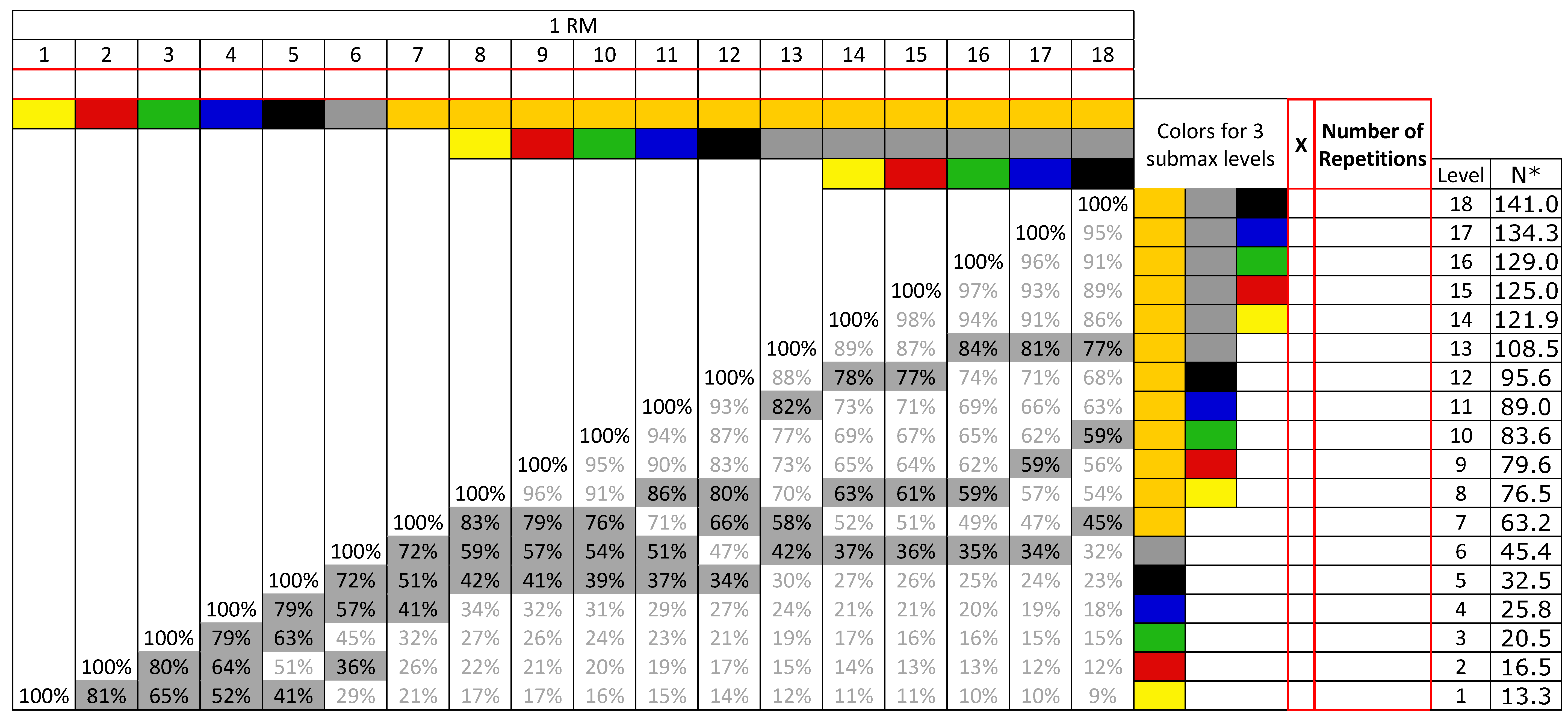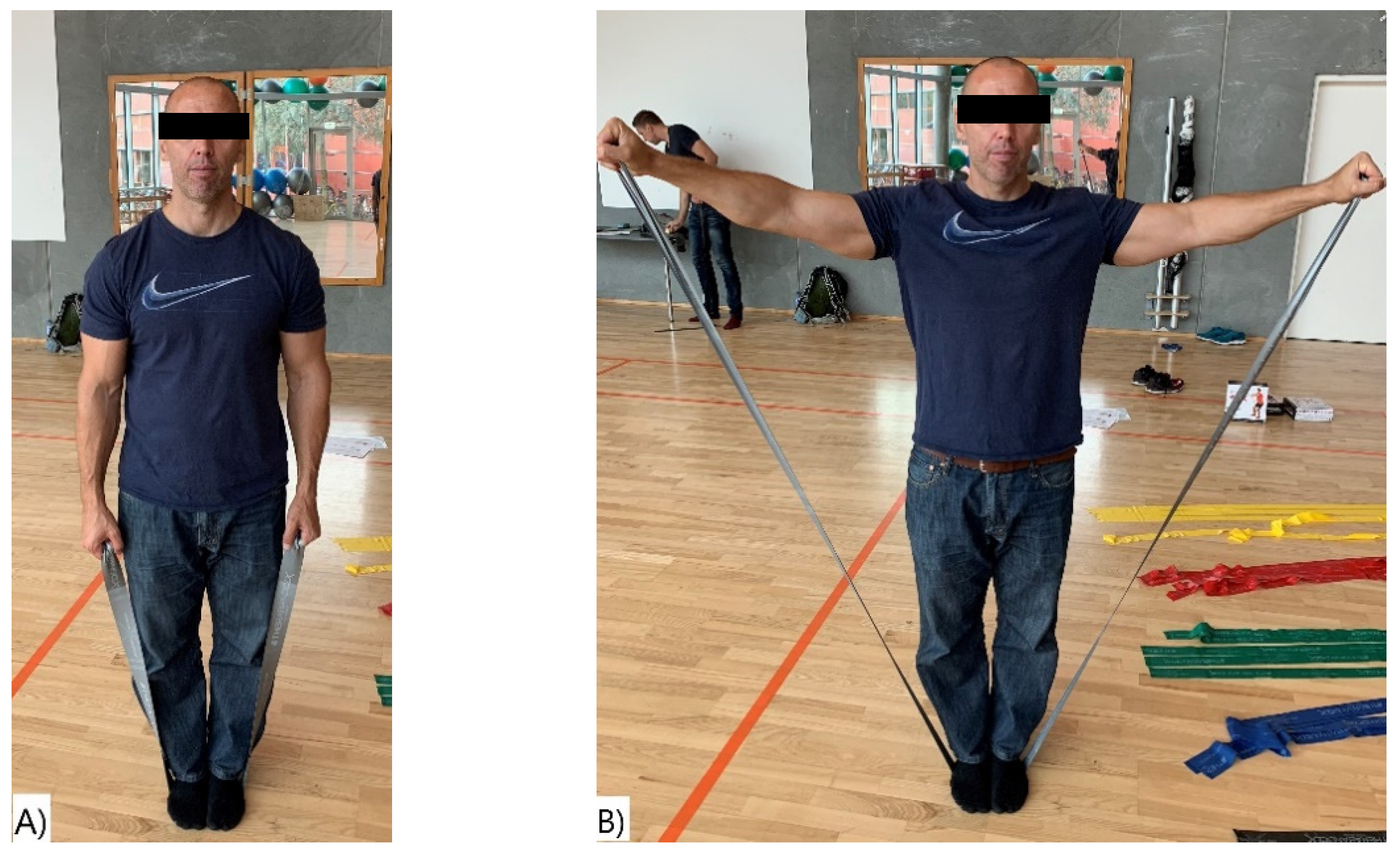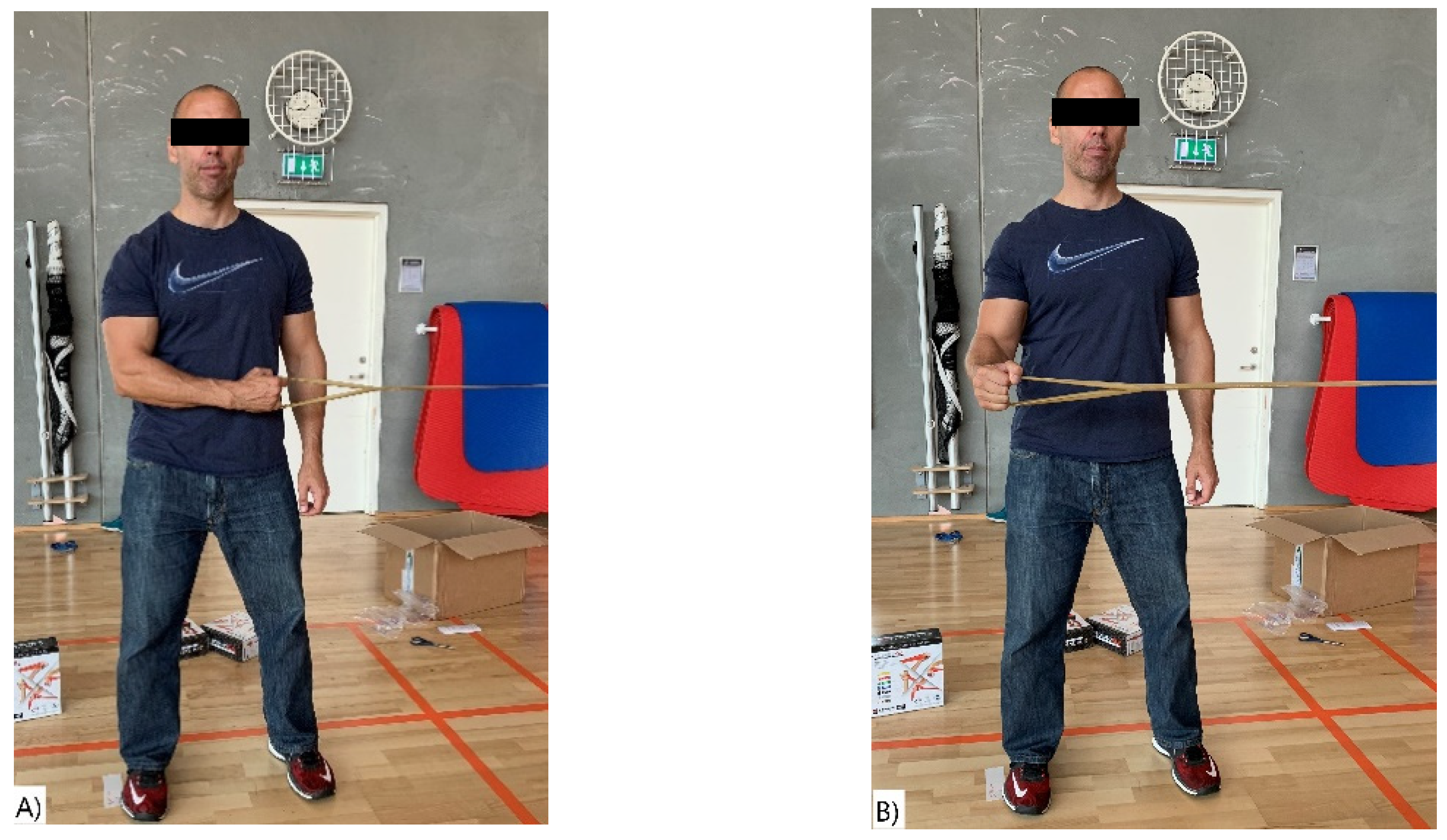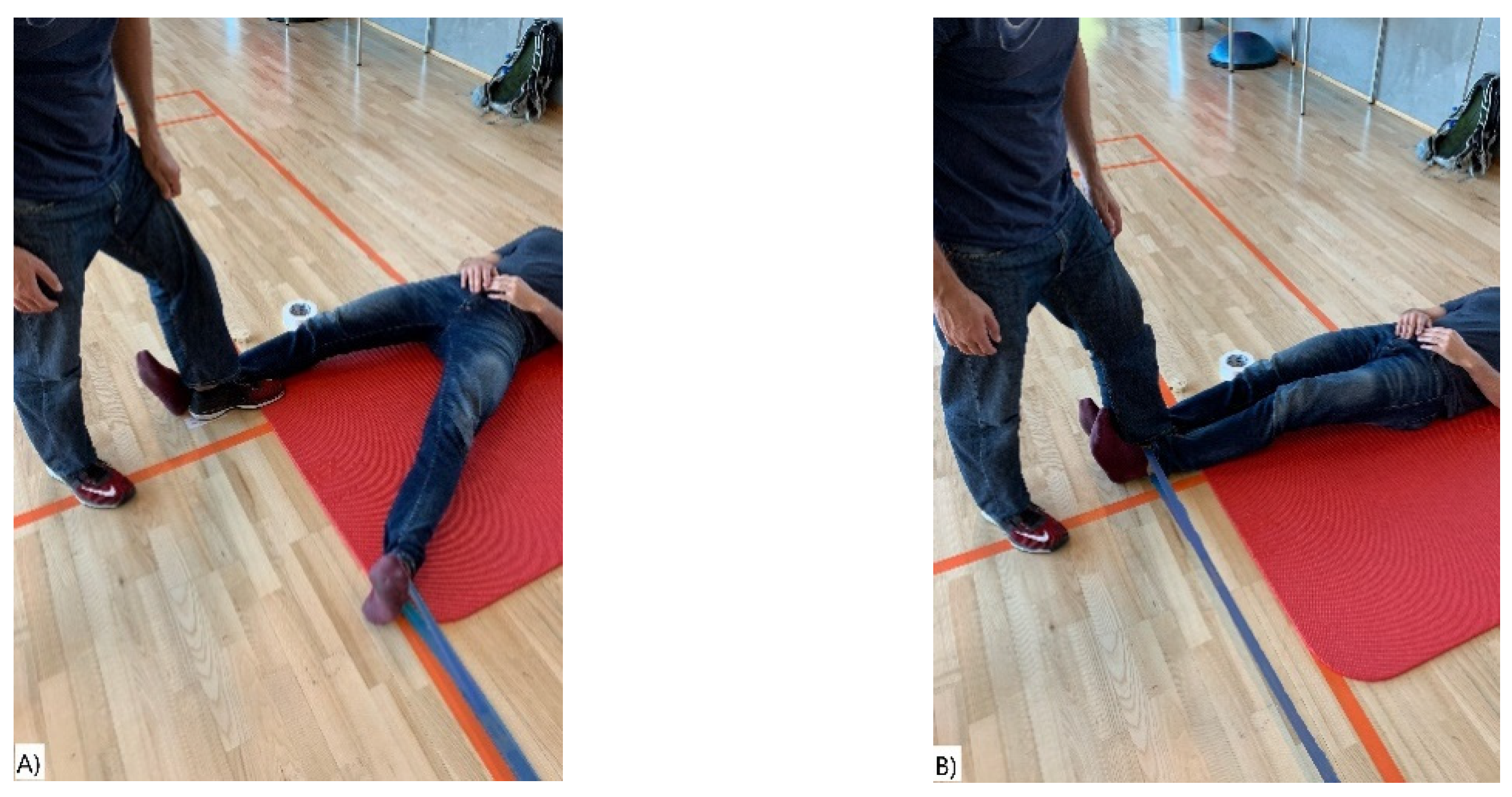Submaximal Elastic Resistance Band Tests to Estimate Upper and Lower Extremity Maximal Muscle Strength
Abstract
1. Introduction
2. Materials and Methods
2.1. Experimental Approach to the Problem
2.2. Subjects
2.3. Procedures
2.3.1. 1 RM Tests
2.3.2. Submaximal Tests
2.4. Exercises
2.4.1. Shoulder Abduction-Standing Bilateral Raises
2.4.2. Shoulder External Rotation
2.4.3. Hip Adduction
2.4.4. Prone Knee Flexion
2.5. Sample Size Calculations
2.6. Statistical Analysis
3. Results
4. Discussion
5. Conclusions
6. Practical Applications
Author Contributions
Funding
Institutional Review Board Statement
Informed Consent Statement
Data Availability Statement
Conflicts of Interest
References
- Matthews, M.J.; Green, D.; Matthews, H.; Swanwick, E. The effects of swimming fatigue on shoulder strength, range of motion, joint control, and performance in swimmers. Phys. Ther. Sport 2017, 23, 118–122. [Google Scholar] [CrossRef]
- Edouard, P.; Degache, F.; Oullion, R.; Plessis, J.-Y.; Gleizes-Cervera, S.; Calmels, P. Shoulder strength imbalances as injury risk in handball. Int. J. Sports Med. 2013, 34, 654–660. [Google Scholar] [CrossRef]
- Madsen, B.K.; Søgaard, K.; Andersen, L.L.; Skotte, J.H.; Jensen, R.H. Neck and shoulder muscle strength in patients with tension-type headache: A case-control study. Cephalalgia 2015, 36, 29–36. [Google Scholar] [CrossRef] [PubMed]
- Costantino, C.; Verdano, M.A.; Jacopetti, M.; Romiti, D.; Lunini, E.; Pellegrini, A.; Ceccarelli, F. Isokinetic strength test and functional outcomes in proximal humeral fractures treated with a locking plate. J. Orthop. Sci. 2014, 19, 776–785. [Google Scholar] [CrossRef] [PubMed]
- Saccol, M.F.; Zanca, G.G.; Ejnisman, B.; De Mello, M.T.; Mattiello, S.M. Shoulder rotator strength and torque steadiness in athletes with anterior shoulder instability or SLAP lesion. J. Sci. Med. Sport 2014, 17, 463–468. [Google Scholar] [CrossRef] [PubMed]
- Thorborg, K.; Serner, A.; Petersen, J.; Madsen, T.M.; Magnusson, P.; Hölmich, P. Hip adduction and abduction strength profiles in elite soccer players. Am. J. Sports Med. 2010, 39, 121–126. [Google Scholar] [CrossRef]
- Santos, H.G.; Chiavegato, L.D.; Valentim, D.P.; Da Silva, P.R.; Padula, R.S. Resistance training program for fatigue management in the workplace: Exercise protocol in a cluster randomized controlled trial. BMC Public Health 2016, 16, 1218. [Google Scholar] [CrossRef]
- Andersen, L.L.; Saervoll, C.A.; Mortensen, O.S.; Poulsen, O.M.; Hannerz, H.; Zebis, M.K. Effectiveness of small daily amounts of progressive resistance training for frequent neck/shoulder pain: Randomised controlled trial. Pain 2011, 152, 440–446. [Google Scholar] [CrossRef]
- Thorborg, K.; Petersen, J.; Magnusson, S.P.; Hölmich, P. Clinical assessment of hip strength using a hand-held dynamometer is reliable. Scand. J. Med. Sci. Sports 2009, 20, 493–501. [Google Scholar] [CrossRef]
- McLaine, S.J.; Ginn, K.A.; Kitic, C.M.; Fell, J.W.; Bird, M.-L. The reliability of strength tests performed in elevated shoulder positions using a handheld dynamometer. J. Sport Rehabil. 2016, 25. [Google Scholar] [CrossRef]
- Alta, T.D.; Veeger, D.; De Toledo, J.M.; Janssen, T.W.; Willems, W.J. Isokinetic strength differences between patients with primary reverse and total shoulder prostheses. Clin. Biomech. 2014, 29, 965–970. [Google Scholar] [CrossRef]
- Edouard, P.; Codine, P.; Samozino, P.; Bernard, P.-L.; Hérisson, C.; Gremeaux, V. Reliability of shoulder rotators isokinetic strength imbalance measured using the Biodex dynamometer. J. Sci. Med. Sport 2013, 16, 162–165. [Google Scholar] [CrossRef]
- Andersen, L.L.; Holtermann, A.; Jørgensen, M.B.; Sjøgaard, G. Rapid muscle activation and force capacity in conditions of chronic musculoskeletal pain. Clin. Biomech. 2008, 23, 1237–1242. [Google Scholar] [CrossRef] [PubMed]
- Machado, A.F.; Almeida, A.C.; Micheletti, J.K.; Vanderlei, F.M.; Tribst, M.F.; Junior, J.N.; Pastre, C.M. Dosages of cold-water immersion post exercise on functional and clinical responses: A randomized controlled trial. Scand. J. Med. Sci. Sports 2016, 27, 1356–1363. [Google Scholar] [CrossRef] [PubMed]
- Micheletti, J.K.; Vanderlei, F.M.; Machado, A.F.; de Almeida, A.C.; Nakamura, F.Y.; Junior, J.N.; Pastre, C.M. A new mathematical approach to explore the post-exercise recovery process and its applicability in a cold water immersion protocol. J. Strength Cond. Res. 2019, 33, 1266–1275. [Google Scholar] [CrossRef] [PubMed]
- Fleck, S.J.; Kraemer, W.J. Designing Resistance Training Programs; Human Kinetics: Champaign, IL, USA, 2004. [Google Scholar]
- American College of Sports Medicine. Progression models in resistance training for healthy adults. Med. Sci. Sports Exerc. 2009, 41, 687–708. [Google Scholar] [CrossRef]
- Coudeyre, E.; Jegu, A.; Giustanini, M.; Marrel, J.; Edouard, P.; Pereira, B. Isokinetic muscle strengthening for knee osteoarthritis: A systematic review of randomized controlled trials with meta-analysis. Ann. Phys. Rehab. Med. 2016, 59, 207–215. [Google Scholar] [CrossRef]
- Pontes, S.S.; De Carvalho, A.L.R.; Almeida, K.D.O.; Neves, M.P.; Schindler, I.F.S.R.; Alves, I.G.N.; Arcanjo, F.L.; Gomes-Neto, M. Effects of isokinetic muscle strengthening on muscle strength, mobility, and gait in post-stroke patients: A systematic review and meta-analysis. Clin. Rehabil. 2018, 33, 381–394. [Google Scholar] [CrossRef]
- Thorborg, K.; Bandholm, T.; Schick, M.; Jensen, J.; Holmich, P. Hip strength assessment using handheld dynamometry is subject to intertester bias when testers are of different sex and strength. Scand. J. Med. Sci. Sports 2011, 23, 487–493. [Google Scholar] [CrossRef]
- Bohannon, R.W. Test-retest reliability of hand-held dynamometry during a single session of strength assessment. Phys. Ther. 1986, 66, 206–209. [Google Scholar] [CrossRef]
- Byl, N.N.; Richards, S.; Asturias, J. Intrarater and interrater reliability of strength measurements of the biceps and deltoid using a hand held dynamometer. J. Orthop. Sports Phys. Ther. 1988, 9, 399–405. [Google Scholar] [CrossRef]
- Newman, B.L.; Pollock, C.L.; Hunt, M.A. Reliability of measurement of maximal isometric lateral trunk-flexion strength in athletes using handheld dynamometry. J. Sport Rehabil. 2012, 21. [Google Scholar] [CrossRef]
- Andersen, L.L.; Vinstrup, J.; Jakobsen, M.D.; Sundstrup, E. Validity and reliability of elastic resistance bands for measuring shoulder muscle strength. Scand. J. Med. Sci. Sports 2016, 27, 887–894. [Google Scholar] [CrossRef]
- Micheletti, J.K.; Pastre, C.M.; Machado, A.F.; Souto, L.R.; Lopes, J.S.S.; Andersen, L.L. Determination of shoulder abduction strength using a submaximal elastic band test. JPHR 2017, 1, 3120. [Google Scholar] [CrossRef][Green Version]
- Guex, K.; Daucourt, C.; Borloz, S. Validity and reliability of maximal-strength assessment of knee flexors and extensors using elastic bands. J. Sport Rehab. 2015, 24, 151–155. [Google Scholar] [CrossRef] [PubMed]
- Nyberg, A. Validity of using elastic bands to measure knee extension strength in older adults. J. Nov. Physiother. Phys. Rehabil. 2016, 3, 16–21. [Google Scholar] [CrossRef]
- Hoeger, W.W.; Hopkins, D.R.; Barette, S.L.; Hale, D.F. Relationship between repetitions and selected percentages of one repetition maximum: A comparison between untrained and trained males and females. J. Strength Cond. Res. 1990, 4, 47. [Google Scholar] [CrossRef]
- Shimano, T.; Kraemer, W.J.; Spiering, B.A.; Volek, J.S.; Hatfield, D.L.; Silvestre, R.; Vingren, J.L.; Fragala, M.S.; Maresh, C.M.; Fleck, S.J.; et al. Relationship between the number of repetitions and selected percentages of one repetition maximum in free weight exercises in trained and untrained men. J. Strength Cond. Res. 2006, 20, 819–823. [Google Scholar] [CrossRef]
- Ørtenblad, N.; Nielsen, J.; Boushel, R.; Söderlund, K.; Saltin, B.; Holmberg, H.-C. The muscle fiber profiles, mitochondrial content, and enzyme activities of the exceptionally well-trained arm and leg muscles of elite cross-country skiers. Front. Physiol. 2018, 9, 1031. [Google Scholar] [CrossRef]
- Hostrup, M.; Bangsbo, J. Limitations in intense exercise performance of athletes—Effect of speed endurance training on ion handling and fatigue development. J. Physiol. 2017, 595, 2897–2913. [Google Scholar] [CrossRef]
- Richardson, R.S.; Secher, N.H.; Tschakovsky, M.E.; Proctor, D.N.; Wray, D.W. Metabolic and vascular limb differences affected by exercise, gender, age, and disease. Med. Sci. Sports Exerc. 2006, 38, 1792–1796. [Google Scholar] [CrossRef] [PubMed]
- Canepari, M.; Pellegrino, M.A.; D’Antona, G.; Bottinelli, R. Skeletal muscle fibre diversity and the underlying mechanisms. Acta Physiol. 2010, 199, 465–476. [Google Scholar] [CrossRef]
- Helge, J.W. Arm and leg substrate utilization and muscle adaptation after prolonged low-intensity training. Acta Physiol. 2010, 199, 519–528. [Google Scholar] [CrossRef] [PubMed]
- Calbet, J.A.; Holmberg, H.-C.; Rosdahl, H.; Van Hall, G.; Jensen-Urstad, M.; Saltin, B. Why do arms extract less oxygen than legs during exercise? Am. J. Physiol. Integr. Comp. Physiol. 2005, 289, R1448–R1458. [Google Scholar] [CrossRef] [PubMed]
- Van Hall, G.; Jensen-Urstad, M.; Rosdahl, H.; Holmberg, H.-C.; Saltin, B.; Calbet, J.A. Leg and arm lactate and substrate kinetics during exercise. Am. J. Physiol. Metab. 2003, 284, E193–E205. [Google Scholar] [CrossRef]
- Ahlborg, G.; Jensen-Urstad, M. Metabolism in exercising arm vs. leg muscle. Clin. Physiol. 1991, 11, 459–468. [Google Scholar] [CrossRef] [PubMed]
- Saltin, B.; Gollnick, P.D. Skeletal Muscle Adaptability: Significance for Metabolism and Performance; American Cancer Society: Atlanta, GA, USA, 2011; pp. 555–631. [Google Scholar] [CrossRef]
- Schiaffino, S.; Reggiani, C. Fiber types in mammalian skeletal muscles. Physiol. Rev. 2011, 91, 1447–1531. [Google Scholar] [CrossRef]
- Richens, B.; Cleather, D. The relationship between the number of repetitions performed at given intensities is different in endurance and strength trained athletes. Biol. Sport 2014, 31, 157–161. [Google Scholar] [CrossRef]
- Manor, B.; Topp, R.; Page, P. Validity and reliability of measurements of elbow flexion strength obtained from older adults using elastic bands. J. Geriatr. Phys. Ther. 2006, 29, 16–19. [Google Scholar] [CrossRef]
- Ebert, J.R.; Webster, K.E.; Edwards, P.K.; Joss, B.K.; D’Alessandro, P.; Janes, G.; Annear, P. Current perspectives of Australian therapists on rehabilitation and return to sport after anterior cruciate ligament reconstruction: A survey. Phys. Ther. Sport 2019, 35, 139–145. [Google Scholar] [CrossRef] [PubMed]
- Hayes, K.W.; Falconer, J. Reliability of hand-held dynamometry and its relationship with manual muscle testing in patients with osteoarthritis in the knee. J. Orthop. Sports Phys. Ther. 1992, 16, 145–149. [Google Scholar] [CrossRef] [PubMed]
- Jackson, S.M.; Cheng, M.S.; Smith, A.R.; Kolber, M.J. Intrarater reliability of hand held dynamometry in measuring lower extremity isometric strength using a portable stabilization device. Musculoskelet. Sci. Pract. 2017, 27, 137–141. [Google Scholar] [CrossRef] [PubMed]






| Participants (men/women) | 26 (11/15) |
| Age (y) | 24.9 ± 6.15 |
| Body mass (kg) | 71.1 ± 12.15 |
| Height (m) | 1.75 ± 0.07 |
| BMI (kg/m2) | 23.0 ± 2.74 |
| Smokers/non-smokers | 1/25 |
| Strength training sessions/week (average) | 2.5 (range 0–8) |
| Number of Repetitions Performed | Intensity | |||
|---|---|---|---|---|
| 100% (SD) | 80% (SD//SE) | 60% (SD//SE) | 40% (SD//SE) | |
| Shoulder abduction | 1 (n/a) | 18 (8.7//1.8) | 30.5 (17.8//3.5) | 48.3 (20.5//4.1) |
| Shoulder external rotation | 1 (n/a) | 22.3 (7.1//1.5) | 29.8 (9.4//1.8) | 53.0 (14.2//2.8) |
| Hip adduction | 1 (n/a) | 16.2 (11.2//2.2) | 35.2 (16.4//3.3) | 86.7 (56.0//11.2) |
| Prone knee flexion | 1 (n/a) | 15.3 (8.7//1.7) | 31.8 (14.0//2.8) | 83.4 (63.3//12.7) |
Publisher’s Note: MDPI stays neutral with regard to jurisdictional claims in published maps and institutional affiliations. |
© 2021 by the authors. Licensee MDPI, Basel, Switzerland. This article is an open access article distributed under the terms and conditions of the Creative Commons Attribution (CC BY) license (http://creativecommons.org/licenses/by/4.0/).
Share and Cite
Haraldsson, B.T.; Andersen, C.H.; Erhardsen, K.T.; Zebis, M.K.; Micheletti, J.K.; Pastre, C.M.; Andersen, L.L. Submaximal Elastic Resistance Band Tests to Estimate Upper and Lower Extremity Maximal Muscle Strength. Int. J. Environ. Res. Public Health 2021, 18, 2749. https://doi.org/10.3390/ijerph18052749
Haraldsson BT, Andersen CH, Erhardsen KT, Zebis MK, Micheletti JK, Pastre CM, Andersen LL. Submaximal Elastic Resistance Band Tests to Estimate Upper and Lower Extremity Maximal Muscle Strength. International Journal of Environmental Research and Public Health. 2021; 18(5):2749. https://doi.org/10.3390/ijerph18052749
Chicago/Turabian StyleHaraldsson, Bjarki T., Christoffer H. Andersen, Katrine T. Erhardsen, Mette K. Zebis, Jéssica K. Micheletti, Carlos M. Pastre, and Lars L. Andersen. 2021. "Submaximal Elastic Resistance Band Tests to Estimate Upper and Lower Extremity Maximal Muscle Strength" International Journal of Environmental Research and Public Health 18, no. 5: 2749. https://doi.org/10.3390/ijerph18052749
APA StyleHaraldsson, B. T., Andersen, C. H., Erhardsen, K. T., Zebis, M. K., Micheletti, J. K., Pastre, C. M., & Andersen, L. L. (2021). Submaximal Elastic Resistance Band Tests to Estimate Upper and Lower Extremity Maximal Muscle Strength. International Journal of Environmental Research and Public Health, 18(5), 2749. https://doi.org/10.3390/ijerph18052749







